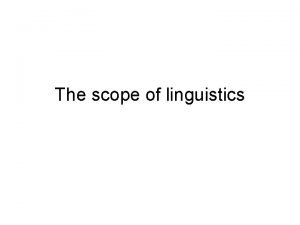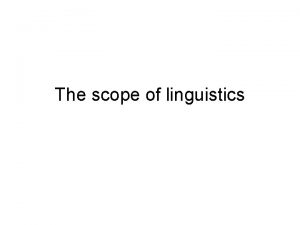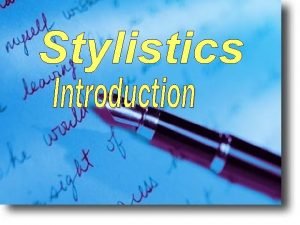SCOPE OF LINGUISTICS MICRO Linguistics Micro linguistics includes







- Slides: 7

SCOPE OF LINGUISTICS MICRO Linguistics

Micro linguistics includes: • • • Phonetics Phonology Morphology Syntax Semantics pragmatics

Micro linguistics • Phonetics is the scientific study of speech sounds. It studies how speech sounds are articulated, transmitted, and received. • Phonology is the study of how speech sounds function in a language, it studies the ways speech sounds are organized. It can be seen as the functional phonetics of a particular language. • Morphology is the study of the formation of words. It is a branch of linguistics which breaks words into morphemes. It can be considered as the grammar of words as syntax is the grammar of sentences.

Micro linguistics • Syntax deals with the combination of words into phrases, clauses and sentences. It is the grammar of sentence construction. • Semantics is a branch of linguistics which is concerned with the study of meaning in all its formal aspects. Words have several types of meaning. • Pragmatics can be defined as the study of language in use. It deals with how speakers use language in ways which cannot be predicted from linguistic knowledge alone, and how hearers arrive at the intended meaning of speakers. PRAGMATICS =MEANING-SEMANTICS.

Macro linguistics includes • • • Sociolinguistics Psycholinguistics Neurolinguistics Discourse analysis Cognitive linguistics Applied linguistics

Macro linguistics • Sociolinguistics studies the relations between language and society: how social factors influence the structure and use of language. • Psycholinguistics is the study of language and mind: the mental structures and processes which are involved in the acquisition, comprehension and production of language. • Neurolinguistics is the study of language processing and language representation in the brain. It typically studies the disturbances of language comprehension and production caused by the damage of certain areas of the brain.

Macro linguistics • Discourse analysis, or text linguistics is the study of the relationship between language and the contexts in which language is used. It deals with how sentences in spoken and written language form larger meaningful units. • Cognitive linguistics is an approach to the analysis of natural language that focuses on language as an instrument for organizing, processing, and conveying information. • Applied linguistics is primarily concerned with the application of linguistic theories, methods and findings to the elucidation of language problems which have arisen in other areas of experience.













